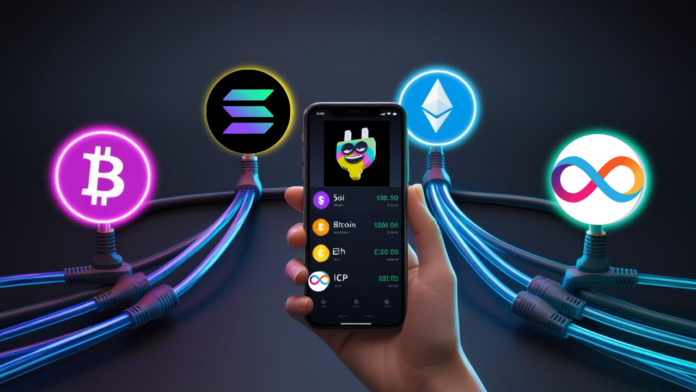Plug Wallet’s mobile app has quietly grown up. The latest update rolls out a unified codebase, syncing the app with its browser extension to create one tidy, seamless experience. There’s a feeling that Plug is no longer playing catch-up — it’s now setting the pace, offering a genuinely smooth, cross-platform wallet that can finally walk the talk on multi-chain support.
Users of Plug’s mobile app can now handle Solana, Bitcoin, Ethereum and Internet Computer with full native support. The wallet doesn’t mess about with bridges or token wrapping. What you hold is what you get — real assets, sitting on their proper chains. The change means Plug can issue dedicated addresses for each of these blockchains, all from the mobile app. No gimmicks, no detours, just actual ownership in your pocket.
Adding this native support is more than a technical detail. It clears a major hurdle for Plug, which has steadily built a presence in the Internet Computer ecosystem but needed more muscle to compete across chains. The app now lets users hold SOL, BTC, ETH, and ICP as they are meant to be held — directly, without relying on synthetic assets. That’s a significant step for anyone who cares about asset sovereignty and security.
The team behind Plug hasn’t stopped at token support either. The update also brings smarter, cleaner swap capabilities. There’s now a second DEX integration baked into the wallet — Kong Swap joins the existing ICPSwap — and the benefit is clear: more liquidity and better prices when moving assets around. You don’t need to hop between platforms or make half-blind guesses on where to swap — it’s all in the app.
To make things even easier, Plug has plugged into Onramper. That means buying crypto from your phone — whether it’s Bitcoin, Ethereum, or Internet Computer — just got a lot less fiddly. The integration offers global coverage and trims down the usual friction of getting funds into your wallet. It won’t solve everything about fiat-to-crypto headaches, but it helps. A lot.
While the tech upgrades are solid, there’s also a clear emphasis on convenience. dApps on the Internet Computer can now be accessed and connected straight from inside the Plug mobile app. It’s the kind of feature that probably should’ve existed earlier, but now that it’s here, it’ll likely become one of those things you wonder how you ever managed without. No more shuffling between browsers, apps, or dodgy workarounds. Just tap and go.
Plug’s evolution has been quietly methodical. What began as an ICP-first wallet now looks like something built for crypto users who want one place to manage multiple chains. And the roadmap gives a decent peek at where it’s going next.
Coming up, Plug plans to introduce Ethereum and Solana DEX integrations, plus staking support for both chains. That’s a hefty promise, but if delivered, it would make Plug a serious contender for anyone active in multi-chain DeFi. There’s also talk of cross-chain DEXs, which suggests Plug is eyeing that hazy but highly prized territory of true chain-agnostic liquidity — where users don’t have to think too hard about what chain they’re operating on because the wallet does the heavy lifting.
It’s this kind of chain-fluid future that Plug seems to be nudging toward. You’ll still need to know what you’re doing, of course, but the app is trying to clear some of the bigger obstacles out of your way. No one enjoys the guesswork involved in figuring out where their tokens live or whether they’re dealing with wrapped versions. That sort of ambiguity doesn’t build trust, especially for mobile users who want to act quickly or casually check balances on the go.
Plug’s update tries to cut through that mess, and it does a pretty decent job of it. Swapping between chains, topping up with fiat, or connecting to a new dApp no longer feels like walking across a tightrope. It just works — and that kind of boring reliability is exactly what most people want from a wallet.
There’s still work to do, and the update doesn’t try to pretend otherwise. Cross-chain staking and DEX access aren’t here yet, and there’s always a danger of overpromising in crypto. But if Plug can hit even half of what’s outlined on the roadmap, it’ll have moved from niche to necessary for a good chunk of the ecosystem.
For those already invested in the Internet Computer, Plug remains the most familiar and intuitive wallet available. But this update widens the net. Bitcoin holders, Ethereum users, Solana fans — all of them now have a reason to take Plug seriously. That’s a shift from its earlier days, when it felt more like a dedicated tool for one community. Now it feels like a bridge for many — not the token-wrapping kind, but the one you actually want to cross.
The broader strategy here seems simple: make crypto management less annoying. And that includes the basics — holding coins, swapping them, buying more, staking, connecting to apps — without bouncing between services or needing a guidebook. The wallet doesn’t claim to reinvent crypto; it just wants to make it feel less broken. That alone makes it worth watching.
So what’s Plug doing differently now? It’s sticking to what people want from wallets — security, clarity, consistency — and cutting the nonsense. The mobile app is no longer a side project; it’s a full-blown extension of the Plug experience. It matches the extension’s capabilities, it works across major chains, and it removes some of the more common headaches. There’s no hype machine behind it, no desperate pitch — just a quiet update that changes how usable crypto can feel on mobile.
In an industry where wallets can often feel bloated, compromised, or clumsy, Plug’s latest move is refreshing for its practicality. This isn’t a reinvention of the wheel. It’s the feeling of finally having tyres that fit.


